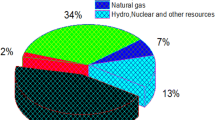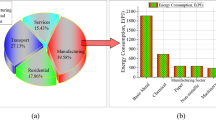Abstract
There is a need to replace non-sustainable conventional coolant (emulsion) with eco benign high-performance cutting fluids such as biodegradable nanofluids that exhibit sufficient lubrication and cooling properties. Also, the sustainability performance of titanium-based alloys can be improved with the geometric alteration on the tool rake zone and by the proper cooling-lubrication mechanism. In the present study, the holistic sustainability of external turning of titanium (Ti–6Al–4V) alloy under two different cutting environments (Al–GnP nanoparticle–based minimum quantity lubrication (MQL) with textured carbide tools and conventional emulsion) is investigated. Novel empirical models for cycle time, machining power, embodied and electrical energy consumption carbon emission, and production cost were developed. For both environments, machining experiments were performed until the cutting tool reaches its life. All sustainable indicators were measured and compared with the conventional process. Results showed that textured carbide cutting tools in the presence of Al–GnP nanoparticle–based MQL-assisted machining (hybrid process) are sustainable environmentally and economically. At the very-high (130 m/min) cutting speed, the sustainable hybrid machining process consumed 1.50% less specific cumulative energy (S_CEC), emitted 5.96% less specific CO2, and incurred 4.33% less specific production cost (S_PC) compared with flood-assisted machining. Finally, it is concluded that the presence of hybrid Al–GnP nanofluids in line texture has the potential to act as lubricant/coolant in turning processes.










Similar content being viewed by others
Data availability
Not applicable
Change history
04 December 2020
An Erratum to this paper has been published: <ExternalRef><RefSource>https://doi.org/10.1007/s00170-020-06436-x</RefSource><RefTarget Address="10.1007/s00170-020-06436-x" TargetType="DOI"/></ExternalRef>
Abbreviations
- 3E:
-
Energy, environment, and economy
- ANOVA:
-
Analysis of variance
- PPC:
-
Portable power clamp
- CE:
-
Carbon emission
- CES:
-
Carbon emission signatures
- CF:
-
Carbon factor
- CEC:
-
Cumulative energy consumption
- LCM:
-
Low carbon manufacturing
- MQL:
-
Minimum quantity lubrication
- TMR:
-
Total material removed
- MVR:
-
Material removal volume
- NMQL:
-
Nanofluid-assisted MQL
- CNC:
-
Computer numerical control
- S _ CEC:
-
Specific cumulative energy consumption
- T (c) :
-
Cycle time
- t (i) :
-
Idle time
- t (a) :
-
Air-cutting time
- l (c) :
-
Cutting length
- t (tc) :
-
Tool change time
- t (TF) :
-
Texture fabrication time
- P (t) :
-
Total power
- P (i) :
-
Idle power
- P (a) :
-
Air-cutting power
- P (tc) :
-
Tool change power
- y (Wp) :
-
Embodied energy of the workpiece
- y (CT) :
-
Embodied energy per cutting edge
- y (nF) :
-
Embodied energy of the lubricating nanofluid
- y (Cp) :
-
Energy for cleaning operation
- TMR:
-
Total material removed
- V (Wp) :
-
Volume of workpiece removed
- V (nF) :
-
Volume of nanofluid consumed
- V (TF) :
-
Embodied energy due to tool fabrication
- V (Fp) :
-
Volume of prepared fluid
- SCE( hybrid):
-
Specific carbon emission (hybrid)
- CE(m) :
-
Carbon emission due to electrical energy emission
- CF(Wp) :
-
Carbon footprints of workpiece
- CF(CT) :
-
Carbon footprints of cutting tools
- CF(nF) :
-
Carbon footprints of nanofluid
- CF(F) :
-
Carbon footprints of emulsion (flood)
- C (e) :
-
Energy cost
- C m :
-
Machining cost
- C (nf) :
-
Cost of nanofluid
- Q (V) :
-
Volume of cutting fluid used
- C (F) :
-
Cost of emulsion (flood)
- C (d) :
-
Disposal (fluid) cost
- SPC(flood) :
-
Specific production cost (flood)
- t (sb) :
-
Standby time
- t (c) :
-
Cutting time
- t (l/c) :
-
Lubrication/coolant time
- l (a) :
-
Air-cutting length
- T (L) :
-
Tool life
- P (sb) :
-
Standby power
- P (su) :
-
Setup power
- P (c) :
-
Power during cutting
- P (l/c) :
-
Compressor/coolant pump power
- E (m) :
-
Machining energy
- y (d) :
-
Energy for disposal operation
- \( {y}_{\left({\mathrm{LN}}_2\right)} \) :
-
Embodied energy of LN2
- y (MQL) :
-
Embodied energy of MQL oil
- S:
-
Emulsion consumption
- y (F) :
-
Embodied energy of emulsion (flood)
- Q (F) :
-
Coolant flow rate
- S _ CEC (flood):
-
Specific cumulative energy consumption (flood)
- S _ CEC (hybrid):
-
Specific cumulative energy consumption (hybrid)
- V (d) :
-
Disposed volume of cutting fluid
- SCE( flood):
-
Specific carbon emission (flood)
- CE(total) :
-
Total CO2 emitted for unit tool life
- CF(TF) :
-
CO2 emissions due to tool texturing process
- CF(Fp) :
-
Carbon footprints of nanofluid preparation
- CF(d) :
-
Carbon footprints of disposal activities
- CE(m) :
-
Carbon emission in the machining process
- C (CT) :
-
Cutting tool cost
- C (Wp) :
-
Workpiece cost
- C (TF) :
-
Texture fabrication cost
- C (env) :
-
Environmental cost
- C (Cp) :
-
Cost due to cleaning (workpiece)
- PC:
-
Production cost
- S _ PC(hybrid):
-
Specific production cost (hybrid)
References
Jamil M, Khan AM, Hegab H, Gong L, Mia M, Gupta MK, He N (2019) Effects of hybrid Al2O3-CNT nanofluids and cryogenic cooling on machining of Ti–6Al–4V. Int J Adv Manuf Technol 102.9-12(2019):3895–3909. https://doi.org/10.1007/s00170-019-03485-9
Said Z, Gupta M, Hegab H, Arora N, Khan AM, Jamil M, Bellos E (2019) A comprehensive review on minimum quantity lubrication (MQL) in machining processes using nano-cutting fluids. Int J Adv Manuf Technol 105:2057–2086. https://doi.org/10.1007/s00170-019-04382-x
Khan AM, He N, Li L, Zhao W, Jamil M (2020) Analysis of productivity and machining efficiency in sustainable machining of titanium alloy. Procedia Manuf 43:111–118. https://doi.org/10.1016/j.promfg.2020.02.122
Jamil M, Khan AM, Gupta MK, Mia M, He N, Li L, Sivalingam V (2020) Influence of CO2-snow and subzero MQL on thermal aspects in the machining of Ti-6Al-4V. Appl Therm Eng 177:115480. https://doi.org/10.1016/j.applthermaleng.2020.115480
Gupta MK, Sood PK, Singh G, Sharma VS (2018) Investigations of performance parameters in NFMQL assisted turning of titanium alloy using TOPSIS and particle swarm optimisation method. Int J Mater Prod Technol 57(4):299–321. https://doi.org/10.1504/IJMPT.2018.095116
Zhang N, Yang F, Liu G (2020) Cutting performance of micro-textured WC/Co tools in the dry cutting of Ti-6Al-4V alloy. Int J Adv Manuf Technol 107:3967–3979. https://doi.org/10.1007/s00170-020-05161-9
Darshan C, Jain S, Dogra M, Gupta MK, Mia M, Haque R (2019) Influence of dry and solid lubricant-assisted MQL cooling conditions on the machinability of Inconel 718 alloy with textured tool. Int J Adv Manuf Technol 105:1835–1849. https://doi.org/10.1007/s00170-019-04221-z
Hao X, Chen X, Xiao S, Li L, He N (2018) Cutting performance of carbide tools with hybrid texture. Int J Adv Manuf Technol 97(9-12):3547–3556. https://doi.org/10.1007/s00170-018-2188-2
Ma F, Zhang H, Cao H, Hon KKB (2017) An energy consumption optimization strategy for CNC milling. Int J Adv Manuf Technol 90(5-8):1715–1726. https://doi.org/10.1007/s00170-016-9497-0
Khan AM, He N, Zhao W, Jamil M, Xia H, Meng L et al (2020) Cryogenic-LN 2 and conventional emulsion assisted machining of hardened steel: Comparison from sustainability perspective. Proc Inst Mech Eng Part B J Eng Manuf. https://doi.org/10.1177/0954405420971992
Huo T, Ren H, Zhang X, Cai W, Feng W, Zhou N, & Wang X (2018) China's energy consumption in the building sector: A Statistical Yearbook-Energy Balance Sheet based splitting method. J Clean Prod 185:665–679
Omer AM (2008) Energy, environment and sustainable development. Renew Sust Energ Rev 12(9):2265–2300
Hegab H, Umer U, Deiab I, Kishawy H (2018) Performance evaluation of Ti–6Al–4V machining using nano-cutting fluids under minimum quantity lubrication. Int J Adv Manuf Technol 5(9-12):4229–4241. https://doi.org/10.1007/s00170-017-1527-z
Singh GR, Sharma VS, Gupta MK (2018) Sustainable drilling of aluminium 6061-T6 alloy by using nano-fluids and Ranque-Hilsch vortex tube assisted by MQL: an optimisation approach. Int J Mach Mach Mater 20(3):252–273. https://doi.org/10.1504/IJMMM.2018.093547
Khan AM, Jamil M, Salonitis K, Sarfraz S, Zhao W, He N et al (2019) Multi-objective optimization of energy consumption and surface quality in nanofluid SQCL assisted face milling. Energies 12(4):710
Priarone PC, Robiglio M, Settineri L (2018) On the concurrent optimization of environmental and economic targets for machining. J Clean Prod 190:630–644. https://doi.org/10.1016/j.jclepro.2018.04.163
Branker K, Adams D, Jeswiet J (2012) Initial analysis of cost, energy and carbon dioxide emissions in single point incremental forming - producing an aluminium hat. Int J Sustain Eng 5:188–198. https://doi.org/10.1080/19397038.2011.634033
OECD (2017) Investment in climate, investing in growth. OECD Publishing, Paris
Al-Ghamdi KA, Hussain G (2017) On the CO2 characterization in incremental forming of roll bonded laminates. J Clean Prod 156:214–225. https://doi.org/10.1016/j.jclepro.2017.04.047
Tipnis VA Product Life Cycle Economic models — towards a comprehensive framework for evaluation of environmental impact and competitive advantage. CIRP Ann Manuf Technol 40:463–466. https://doi.org/10.1016/S0007-8506(07)62030-7
Kalpakjian S, Schmid S (1995) Manufacturing engineering and technology, 6th eddition edn. Addision-Wesley Publishing Company Inc (1992). https://www.academia.edu/38175528/Manufacturing_Engineering_and_Technology_6th_Edition_Serope_Kalpakjian_Stephen_Schmid_pdf
Khan AM, Gupta MK, Hegab H et al (2020) Energy-based cost integrated modelling and sustainability assessment of Al-GnP hybrid nanofluid assisted turning of AISI52100 steel. J Clean Prod 257:120502. https://doi.org/10.1016/j.jclepro.2020.120502
Khan AM, Jamil M, Mia M, He N, Zhao W, Gong L (2020) Sustainability-based performance evaluation of hybrid nanofluid assisted machining. J Clean Prod 257:120541. https://doi.org/10.1016/j.jclepro.2020.120541
Yan J, Li L (2013) Multi-objective optimization of milling parameters-the trade-offs between energy, production rate and cutting quality. J Clean Prod 52:462–471. https://doi.org/10.1016/j.jclepro.2013.02.030
Jeswiet J, Kara S (2008) Carbon emissions and CESTM in manufacturing. CIRP Ann Manuf Technol 57:17–20. https://doi.org/10.1016/j.cirp.2008.03.117
Mia M, Gupta MK, Lozano JA, Carou D, Pimenov DY, Królczyk G, Dhar NR (2019) Multi-objective optimization and life cycle assessment of eco-friendly cryogenic N2 assisted turning of Ti-6Al-4V. J Clean Prod 210:121–133. https://doi.org/10.1016/j.jclepro.2018.10.334
Sugihara T, Enomoto T (2017) Performance of cutting tools with dimple textured surfaces: a comparative study of different texture patterns. Precis Eng 49:52–60
Gupta MK, Song Q, Liu Z, Sarikaya M, Jamil M, Mia M, Krolczyk GM (2021) Experimental characterisation of the performance of hybrid cryo-lubrication assisted turning of Ti–6Al–4V alloy. Tribol Int. https://doi.org/10.1016/j.triboint.2020.106582
Chinchanikar S, Choudhury SK (2014) Hard turning using HiPIMS-coated carbide tools: wear behavior under dry and minimum quantity lubrication (MQL). Meas J Int Meas Confed 153:106582. https://doi.org/10.1016/j.measurement.2014.06.002
Singh R, Dureja JS, Dogra M, Gupta MK, Mia M (2019) Influence of graphene-enriched nanofluids and textured tool on machining behavior of Ti-6Al-4V alloy. Int J Adv Manuf Technol 105(1-4):1685–1697. https://doi.org/10.1007/s00170-019-04377-8
Rajemi MF, Mativenga PT, Aramcharoen A (2010) Sustainable machining: selection of optimum turning conditions based on minimum energy considerations. J Clean Prod 18:1059–1065. https://doi.org/10.1016/j.jclepro.2010.01.025
Gupta MK, Sood PK, Sharma VS (2016) Optimization of machining parameters and cutting fluids during nano-fluid based minimum quantity lubrication turning of titanium alloy by using evolutionary techniques. J Clean Prod 135:1276–1288. https://doi.org/10.1016/j.jclepro.2016.06.184
Acknowledgements
The authors are also thankful to Nanjing University of Aeronautics & Astronautics, PR China, and the GIK Institute, Pakistan, for technical assistance and resource provision. The authors would like to acknowledge the efforts made by Dr. Munish Kumar Gupta and Mr. Mozammel Mia for their valuable suggestion to improve the manuscript.
Funding
The authors received funding from the Raytheon Chair for Systems Engineering.
Author information
Authors and Affiliations
Contributions
Conceptualization: AMK, MHA, and AA; methodology: AMK, AA, and GH; software: AMK, GH, and AA; data curation: AMK, MA, and MHA; writing—original draft preparation: AMK and MA; visualization: AMK and MA; investigation: AMK, AA, and GH; supervision: NH and GH; validation: AA, MHA, and GH; writing—reviewing and editing: NH and GH; funding: NH.
Corresponding authors
Ethics declarations
Ethical approval and consent to participate
Not applicable
Consent of publication
The copyright permission has been taken, and consent to submit has been received explicitly from all authors.
Competing interests
The authors declare that they have no competing interests.
Additional information
Publisher’s note
Springer Nature remains neutral with regard to jurisdictional claims in published maps and institutional affiliations.
Rights and permissions
About this article
Cite this article
Khan, A.M., Hussain, G., Alkahtani, M. et al. Holistic sustainability assessment of hybrid Al–GnP-enriched nanofluids and textured tool in machining of Ti–6Al–4V alloy. Int J Adv Manuf Technol 112, 731–743 (2021). https://doi.org/10.1007/s00170-020-06371-x
Received:
Accepted:
Published:
Issue Date:
DOI: https://doi.org/10.1007/s00170-020-06371-x




